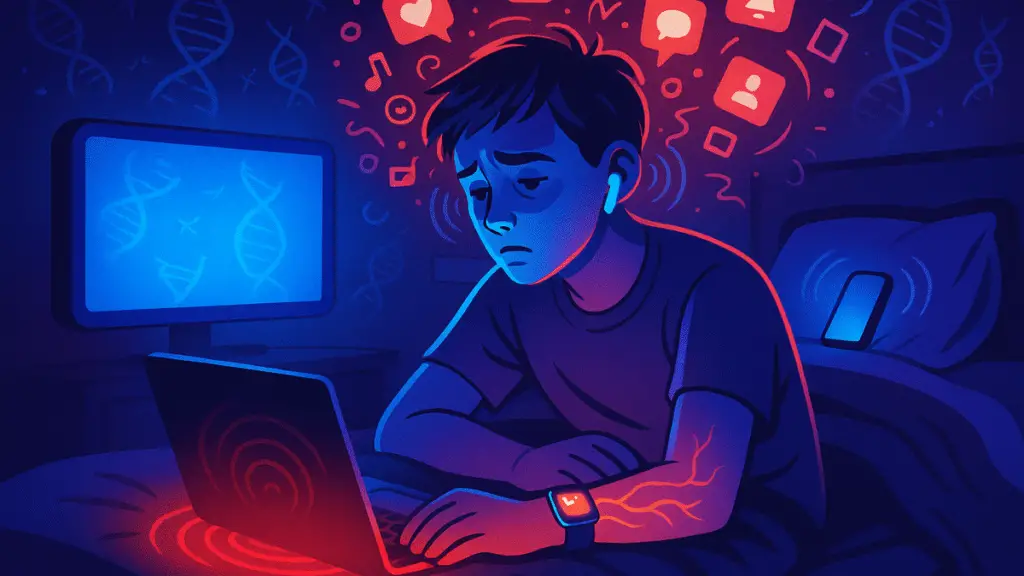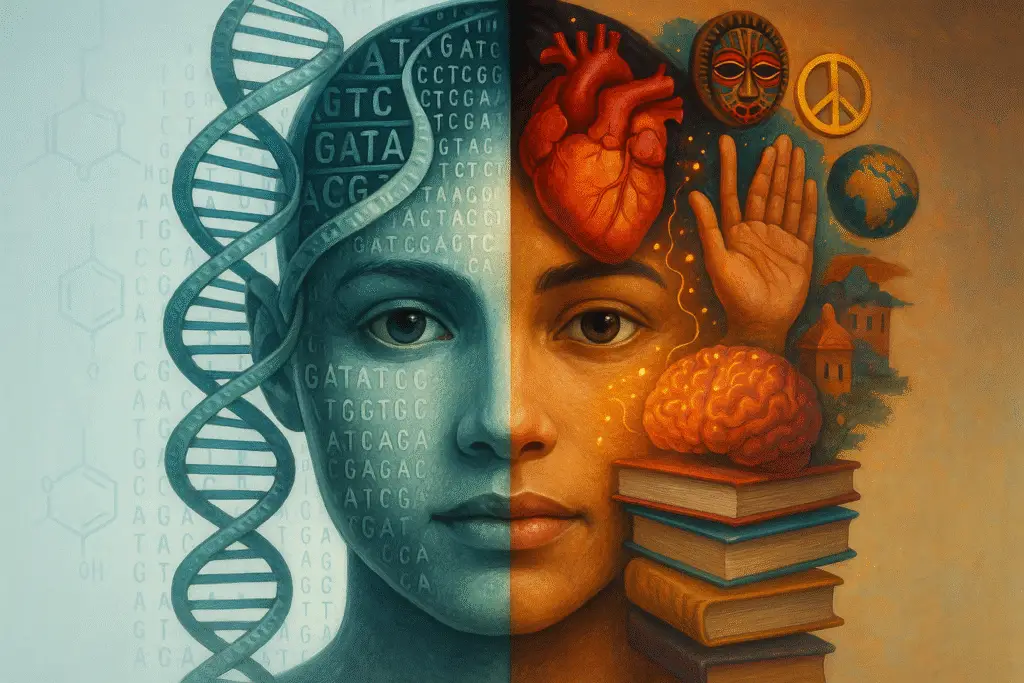Our day-to-day life is tech-heavy. Starting our day with an alarm to work for long-10 hours on a laptop, technology surrounds our lives. Mobile, laptop, microwave, wifi, smart TV, smart watch and smart voice control are the new comforts.
We extensively rely on technology and these gadgets!
Technology is making our lives easier and better, but at the same time, it has adverse consequences on our health.
Research suggests that the extensive use of these gadgets impacts our physical and mental health. But do you know, it also hurts our DNA.
Yes, you heard it right.
In this article, I am going to explain seven daily, routine and common tech habits that are hurting your DNA and you don’t know about it.
Key Topics:
7 Daily Tech Habits That Might Be Hurting Your DNA
Using a laptop on your lap for hours
A laptop or a computer is a daily need now. Students, professionals, and even housewives need a laptop for their daily work. Sit on the sofa or bed, take the laptop on your lap and just start working!
Eternal work comfort, right!
A laptop can cause DNA damage and disruption in genetic expression through non-ionizing electromagnetic radiation, blue-visible light, heat, connection with wifi, mobile data and Bluetooth.
A meta-review published in the Arab Journal of Urology on overusing a laptop, on your lap and connected to a wireless network causes cellular and DNA damage, DNA fragmentation, and oxidative stress.
This leads to testicular hyperthermia, oligo and azoospermia and infertility in males. Studies further found that the damage becomes more aggressive when the device is connected to the wireless network.
Sleeping next to your phone
This is the most common habit most people have, especially in youngsters. You already know why.
They have a habit of talking, messaging and posting late at night. And then put their phone on the bedside and sleep. The phone often remains connected to the Internet or wifi.
Now, this causes serious problems.
A study published in the Journal of Electromagnetic Biology and Medicine reported DNA damage in human ear canal hair follicle cells from exposure to the non-ionizing radiation emitted from the mobile phone.
The reason is, even after we are not using it and during sleep, the mobile phone is still active, doing background processes, collecting data and even running on the Internet.
A study published in the Iran Journal of Basic Medical Science on pregnant mouse placenta showed that Wifi (over 2.4 GHz) induces DNA damage, affects antioxidant capacity and alters the expression of DNA repair genes.
Besides, faulty mobile phones often blast, so it is dangerous!
Wearing a Bluetooth Device all day
Wearable Bluetooth devices or headphones use low-intensity radiofrequency (RF-EMF), similar to our WiFi or mobile, however, their intensity is too low. In addition, it emits low-level non-ionizing radiation.
Hence, unlike UV or X-rays, it can’t directly damage the DNA. But a review published in Electromagnetic Biology and Medicine showed that the higher dose or extensive use of low-intensity radiofrequency causes oxidative stress and DNA damage.
In addition, as it always remains nearer to the brain, it has a significant negative effect on our brain and ears.
Constant notification = Constant stress
A minute without a ping isn’t possible in this digital era! Every ping, alert, or notification triggers a tiny stress response in our brain. And if it’s someone we don’t wanna talk to, then the stress meter will be even higher.
Now, what does it do? It releases the stress hormone– Cortisol.
Cortisol is a steroid hormone released during stressful conditions. At the molecular level, by binding with the glucocorticoid receptor, and through a series of other molecular cascades, it affects transcription activities and the protein synthesis process for genes.
Meaning, it alters gene expression, suggests a study published in the Journal of Psychoneuroendocrinology. This random over- or underexpression disrupts gene activity and leads to conditions like cancer.
Besides, as we know, cortisol has a wide range of side effects such as weight gain, muscle weakness, high blood pressure and sugar.
No digital detox at all
In this capitalist society, we work for 60 to 70 hours a week and enjoy a day off on Sunday. To detox ourselves from work stress.
But have you ever thought of a digital detox? Our gadgets, like a mobile, a laptop or earbuds, are always with us. Overuse (that we all are doing) of mobile or gadgets leads to mental exhaustion, stress and sleep disruption.
As we explained, hormones like cortisol take charge of our brain and cause serious genetic damage. These alterations in the cellular mechanism and disruption of circadian rhythm and genes alter our epigenetic profile.
Overusing blue light screens
Besides gadgets, holdings, digital advertising displays and party lights, all LED displays emit blue lights. Now, this has two different impacts.
First, a study published in Elsevier showed that overexposure to LED displays causes oxidative and genotoxic stress and DNA damage, directly.
Second, it disrupts our sleep patterns or circadian clock. It directly affects melatonin production, which is an enzyme produced only during the dark and helps us sleep. And during that deep sleep, our DNA repair system starts its “night shift.”
Meaning, it not only damages the DNA directly but also damages the DNA repair machinery.
Wifi or Mobile Data
Our mobile data or Wifi remains always ‘ON’ for a long ‘work day’ and late ‘binge-watch’ night.
Wifi or mobile data emits radiofrequency electromagnetic radiation. Studies showed that constant exposure to Wifi (2.4 GHz or more) affects antioxidant capacity and activity of DNA repair genes.
We have already explained this point.
Read this article to learn more about the effect of Wi-Fi on our DNA: Can Wi-Fi Ready Damage Your DNA?- Here is What Science Says.
What to do?
Now, the question you may have is, what can we do? Shall we throw away all our phones and quit our jobs?
No. You just need to manage tech use.
First and foremost, you have to quit these bad habits– using a laptop on your lap, scrolling late at night, putting your mobile on your bedside and constantly checking your notifications.
Your half of the work will be done here!
Next, do a digital detox once weekly and then for an hour a day. No laptop, no mobile, no display, no advertisement, nothing. Just a book, you and your partner. That’s it.
Isn’t that easy? Give it a try.
After that, develop these habits, turn off WiFi, data, and notifications at night, and also during the digital detox hour.
Avoid overusing any gadget.
Related articles:
- Is Migraine Genetic

- 7 Rare Case Scenarios of Taste and The Genetics Behind Them

- 5 Traits You Won’t Believe Are Genetic

- How Malnutrition Can Affect Our Genetic Health

- How Fasting Can Benefit Your Genetics

Wrapping up:
This article is a wake-up call for all of us. Digitalization is good, but we need to balance it. Overuse of anything is harmful. It is possible that it can’t show any effect on you, but it can be inherited to your children.
DNA has a long-term effect, keep in mind. So it is our responsibility to preserve our DNA in a good state for our future generations.
Share this article if you like it and subscribe to Genetic Education for more such amazing content.
Resources:
- Kavoussi, P. K., & Kavoussi, S. K. (2024). Do mobile phones and laptop computers really impact sperm? Arab Journal of Urology, 1–6. https://doi.org/10.1080/20905998.2024.2381957.
- Avendaño, C., Mata, A., Sanchez Sarmiento, C. A., & Doncel, G. F. (2012). Use of laptop computers connected to internet through Wi-Fi decreases human sperm motility and increases sperm DNA fragmentation. Fertility and Sterility, 97(1), 39-45.e2. https://doi.org/10.1016/j.fertnstert.2011.10.012.
- Akdag, M., Dasdag, S., Canturk, F., & Akdag, M. Z. (2018). Exposure to non-ionizing electromagnetic fields emitted from mobile phones induced DNA damage in human ear canal hair follicle cells. Electromagnetic Biology and Medicine, 37(2), 66–75. https://doi.org/10.1080/15368378.2018.1463246.
- Homeira Vafaei, Ghazal Kavari, Hamid Reza Izadi, Zahra Zare Dorahi, Mehdi Dianatpour, Afrooz Daneshparvar, & Iman Jamhiri. (2020). Wi-Fi (2.4 GHz) affects anti-oxidant capacity, DNA repair genes expression and, apoptosis in pregnant mouse placenta. PubMed, 23(6), 833–840. https://doi.org/10.22038/ijbms.2020.40184.9512.
- Yurtsever, T., Streit, F., Foo, J. C., Trifonova, S., Kumsta, R., Muller, C. P., Turner, J. D., Meyer, J., & Schote, A. B. (2019). Temporal dynamics of cortisol-associated changes in mRNA expression of glucocorticoid responsive genes FKBP5, GILZ, SDPR, PER1, PER2 and PER3 in healthy humans. Psychoneuroendocrinology, 102, 63–67. https://doi.org/10.1016/j.psyneuen.2018.11.033.
- Walsh, K. D., Burkhart, E. M., Nagai, A., Aizawa, Y., & Kato, T. A. (2021). Cytotoxicity and genotoxicity of blue LED light and protective effects of AA2G in mammalian cells and associated DNA repair deficient cell lines. Mutation Research. Genetic Toxicology and Environmental Mutagenesis, 872, 503416–503416. https://doi.org/10.1016/j.mrgentox.2021.503416.


